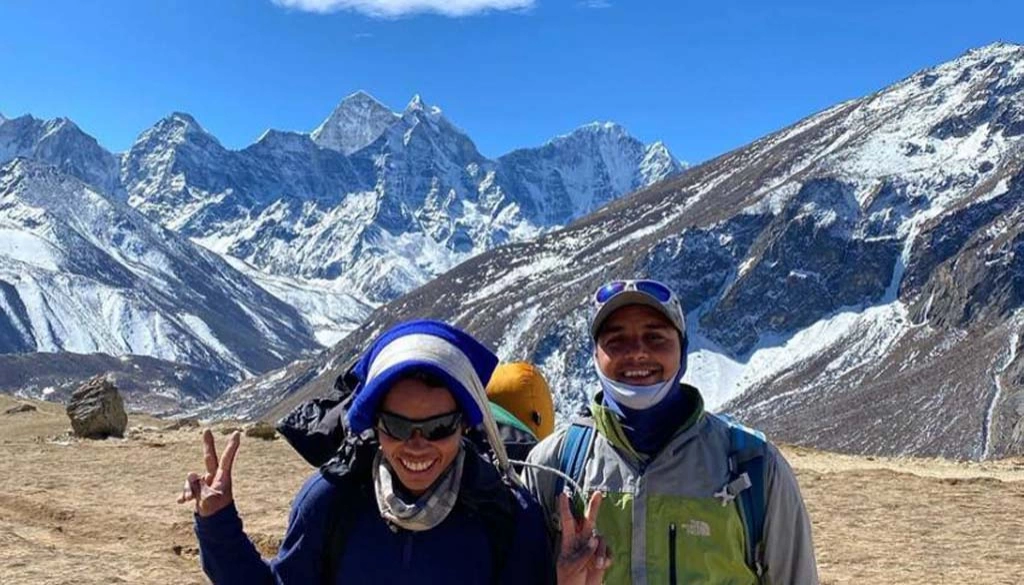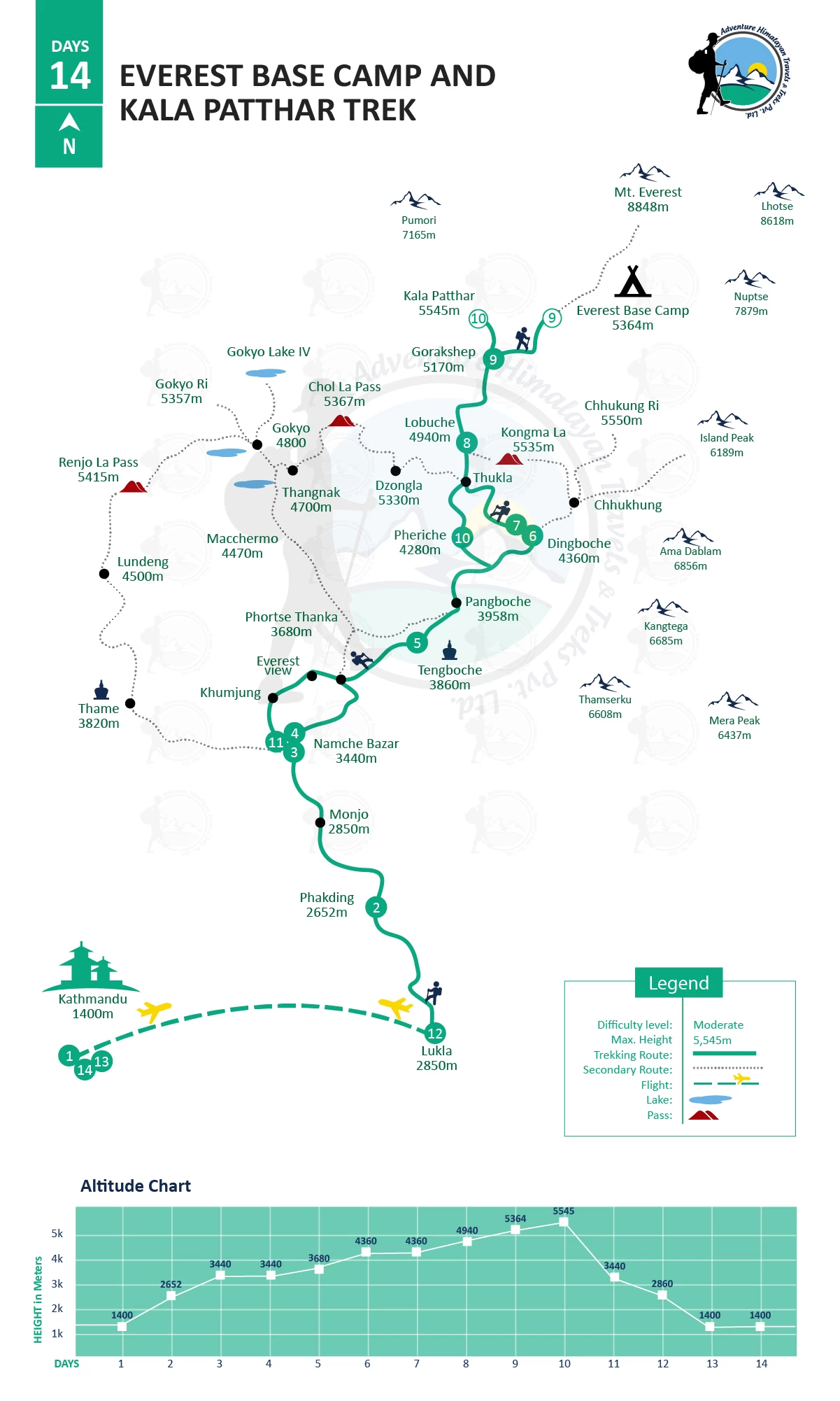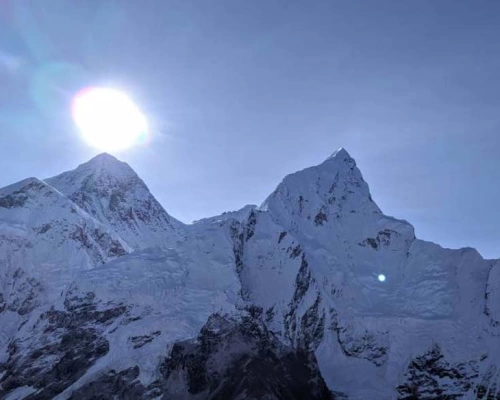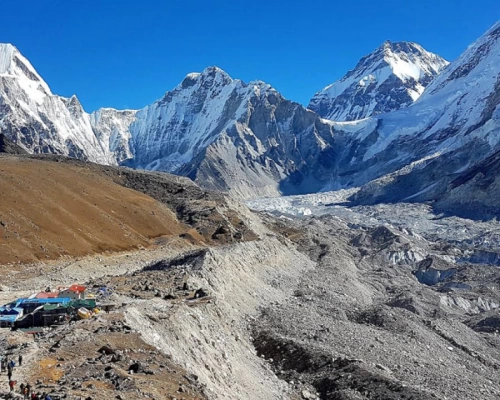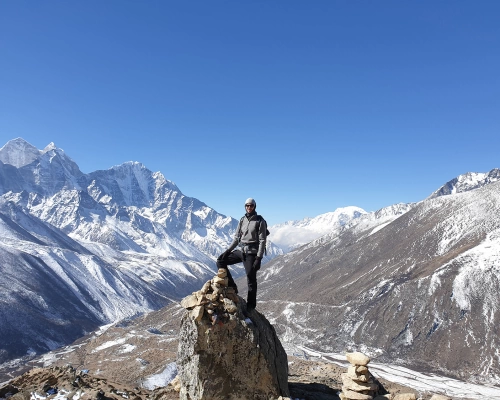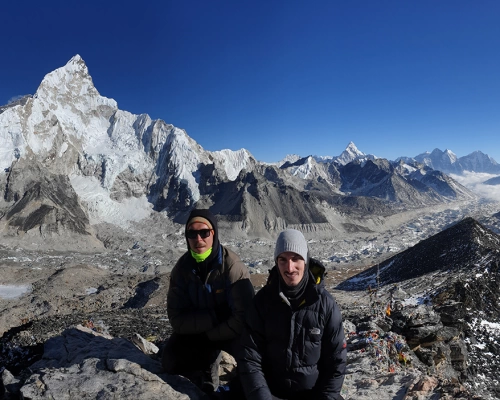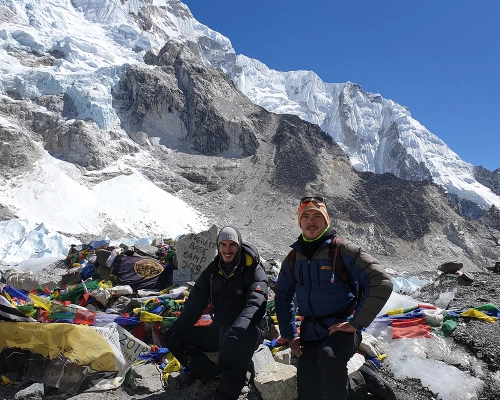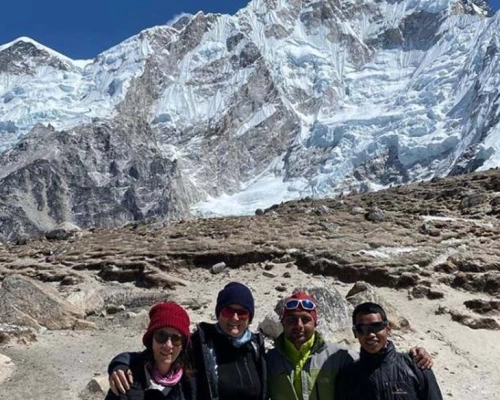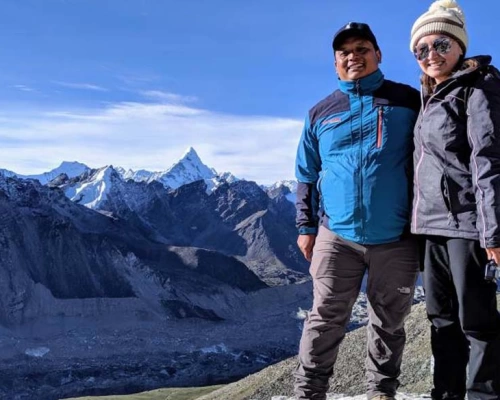This Everest Base Camp to Kalapatthar Trek is a short yet exhilarating journey through the heart of the Everest/Khumbu region of Nepal that leads to the summit of Everest, offering a perfect blend of stunning landscapes, cultural immersion, otherworldly mountain views, the Khumbu Icefall, the Khumbu Glacier, the world’s highest peak, and an unforgettable sense of achievement. Typically starting with a 25-40 minute mountain flight to Lukla, the traditional Everest Trek start and end point, trekkers follow the iconic classic Everest Base Camp trail through picturesque Sherpa villages like Namche Bazaar, Tengboche, and Dingboche, including Gorak Shep, Everest Base Camp, and Kala Patthar.
Along the way, trekkers, travelers, and visitors are greeted with stunning views of Everest, Lhotse, Nuptse, and Ama Dablam, passing by lush forests, adrenaline-rushing suspension bridges over gushing rivers, and charming Sherpa villages, as well as opportunities to visit monasteries and immerse themselves in the spiritual essence of the Khumbu region in a short amount of time. Nature lovers and adventurers alike will get to enjoy the sweeping transitions in the landscape into a stark, high-altitude, desert-like, barren land from subtropical lowlands, culminating at Everest Base Camp, the climb starting point of expeditions to the world’s tallest peak, buzzing with climbers and trekkers from around the globe, specifically during spring and autumn.
However, the journey continues. After standing in the shadow of the world’s highest peak, a hike to Kalapatthar (5,545 m), a popular viewpoint, adds much to the breathtaking experience, offering the closest views of Mount Everest along with a 360-degree sight of other surrounding peaks, especially during sunrise and sunset. The sense of serenity and achievement is otherworldly as you witness the Himalayan panorama bathed in golden sunlight during the sunrise, far away from city crowds, a haven for mountain lovers, naturalists, and photographers. Added much by the warm hospitality of friendly Sherpa people welcoming you with open hearts, fostering deep cultural understanding, the Everest Base Camp to Kalapatthar Trek is a specially designed Everest Trek for those wanting to experience the altitude of 5,364 m without pick up, drop off, and the Kathmandu Sightseeing Tour.
To conclude, this Everest Base Camp to Kalapatthar Trekking 11 Days itinerary is a unique adventure offering a glimpse into the diverse natural and cultural beauty of the Everest Himalayas of Nepal that combines the thrill of trekking in the world’s highest mountain range with Sherpa culture and architecture reflecting the strong influence of Tibetan Buddhism. Though any individual with a good level of physical fitness, if prepared and acclimatized well, can conquer this Himalayan expedition, expect high altitudes and rugged terrain precisely during the ascent to Everest Base Camp and Kala Patthar. At the same time, you soak in the region’s rich Buddhist heritage, highlighted by colorful prayer flags and ancient monasteries.
What makes the Everest Base Camp to Kalapatthar Trek special?
There are several things that make this exciting Everest Himalayan Odyssey, the Everest Base Camp to Kalapatthar Trekking, packed with natural wonders, cultural experiences, and physical challenges, stand out. Trekkers can always look forward to a combination of adventure, spectacular scenery, cultural richness, and a relatively shorter itinerary without any comparison of highlights that the Everest Trekking region has to offer.
Here’s what makes this fast-paced Everest Adventure special: it must be added to your bucket list for 2025 and 2026 with Adventure Himalayan Travels and Treks:
A thrilling start with the Everest Moutain Flight to Lukla
Your Everest Base Camp to Kalapatthar Adventure begins with a flight to Lukla at 2,860m above sea level, home to Tenzing-Hillary Airport, renowned as one of the most adrenaline-rushing airstrips in the world. Serving as the gateway to the Everest/Khumbu region, the flight to Lukla offers a bird’s-eye view of the terraced landscapes, dense forests, traditional settlements, and the Himalayas, including a sneak peek of Mount Everest before landing.
Perched on a steep hillside with a dramatic drop at one end the tiny Lukla airstrip with a runway of just 527m provides trekkers with an unforgettable introduction to the grandeur of the world’s highest peaks that not only saves time but also keeps them excited for what Everest region unfolds for you.
Immersion in Sherpa culture
The Everest Base Camp to Kalapatthar Trekking Trail winds through lush forests, crossing high suspension bridges draped with prayer flags over the roaring rivers, and typical mountain villages largely populated by Sherpa people such as Namche, Tengboche, Dingboche, and Lobuche. Celebrated worldwide for their outstanding mountaineering skills and resilience along the trekking route, you will experience their unique lifestyle, warm hospitality, and spiritual traditions dipped into Tibetan Buddhism.
As you come across several religious and cultural monuments, such as Tengboche Monastery, and learn about the Sherpa’s deep connection to Buddhism and the monastery, it leaves you with a long-lasting, life-changing impression. Located at 3,867m/12,687ft in the Khumbu region of Nepal, Tengboche Monastery alone is a must-visit destination for its stunning views of Mount Everest, Ama Dablam, and other peaks in serenity, providing a fantastic spot for spiritual rejuvenation.
Surrounded by tranquil forests amidst the gigantic Himalayas, Tengboche is the largest monastery in the area and is a spiritual hub for Sherpas that hosts the annual “Mani Ridum” and “Tilije” festivals, attracting both pilgrims and trekkers. Further, this unmatched cultural experience is enhanced by day-to-day encounters with several Mani walls, chortens, and prayer wheels reflecting the region’s Tibetan Buddhist heritage. The Everest Base Camp to Kalapatthar Trek, therefore, is an extraordinary cultural treasure hunt.
Panoramic views during sunrise at Kala Patthar
Though trekkers are blessed with the striking mountain vista right from the beginning of the Himalayan Odyssey to the Everest Base Camp to Kala Patthar, the sunrise from Kalapatthar is truly unparalleled. At 5,545 m, this iconic vantage point provides a close-up, unobstructed, 360-degree, complete view of Everest, Nupste, Pumori, and the Khumbu Glacier, whose beauty is further enhanced as they bathe in golden light during sunrise.
As the highest point of the trek to the Everest Base Camp, these views are a source of motivation as you trek through some challenging sections, such as steep ascents and descents, rugged terrain, and high altitude, including the frequently changing Himalayan weather. However, it is also immensely rewarding, providing you with a true sense of achievement as you experience a magical sunrise, observing the dramatic interplay of colors over the green valleys below and contrasting snow-capped mountain ranges perched above the sky, making it the pinnacle of the Everest Base Camp journey.
Ascending to High Altitude Everest Base Camp: the Gateway to Everest
As you reach the Everest Base Camp during the Everest Base Camp to Kalapatthar Trekking, you will notice the shift in the trail from alpine forests to rocky moraines and snow-dusted landscapes. Air gets thinner, crisper, and colder due to high altitude, allowing profound serenity and adventure that is also followed by the risk of acute mountain sickness (AMS), commonly also known as altitude sickness. Therefore, it is important that you ascend without rushing, stay hydrated, and consume healthy foods, especially ginger and garlic soup, which has proven to be beneficial to mitigate the symptoms of altitude sickness and enjoy to the fullest.
It will be epic to arrive at the legendary destination at 5,364m/17,597ft, serving as the staging area for climbers attempting to summit Mount Everest (8,848m), the top of the world. Embodying the raw Himalayan wilderness and the allure of the world’s tallest mountain, though you might not be able to see the summit, you will not be disappointed by the dizzying view of Nuptse, Khumbu Icefall, and other Himalayan peaks. Further, it will be inspiring to meet brave mountaineers proceeding to the top of the peak, which is a rewarding as well as emotional experience for many.
Short yet Comprehensive Adventure
Due to the increasing popularity of the Everest Trekking region, which boasts several epic Himalayan trekking and climbing routes, such as Everest Base Camp and Gokyo Lake Trek via Cho La Pass, Everest Base Camp Three High Pass Trek, Mera Peak Climbing, and the area now facilitates well-established trails featuring local tea houses, lodges, and guest houses throughout the journey that take care of essential food and accommodation, providing trekkers flexibility to customize their itinerary as per their needs, preferences, and interests.
One such is this 11-day Everest Base Camp to Kalapatthar Trek. Ideal for those with limited time, though short-spanning for less than two weeks, this Himalayan Voyage still offers you a comprehensive and fulfilling Himalayan experience. The journey progresses through the classic route, including dense forests, vibrant Sherpa towns, and rugged alpine terrain around Everest Base Camp and Kala Patthar, skipping arrival and departure days, including one acclimatization day in Dingboche included in the standard trek.
Hence, this 11-day trekking is convenient for experienced or physically fit trekkers familiar with high altitudes with a strong desire to experience the essence of Everest Trekking, catering to adventurers with a passion for nature, culture, and personal achievement, delivering an unforgettable exploration of the Himalayas.
Why Everest Base Camp to Kalapatthar Trek 11 Days itinerary?
The Everest Trekking region of Nepal offers flexible itineraries that Adventure Himalayan Travels and Treks can further customize to meet your needs, preferences, goals, and areas of interest. We offer tailor-made personalized packages that are specially crafted to cater to our client's time constraints and purposes; one such is this 11-day Everest Base Camp to Kalapatthar Trek in 11 Days. Following the classic Everest Route once explored by the legends themselves, Sir Edmund Hillary and Tenzing Norgay Sherpa, this 11-day itinerary for the trek to Everest Base Camp to Kalapatthar is a popular alternative for those who want to experience and discover the major highlights of the Everest region while optimizing time and energy.
Designed for adventurers with good fitness, the trek is physically demanding yet achievable, where the shorter trek avoids unnecessary detours, focusing on reaching the iconic Everest Base Camp and Kala Patthar. However, you will not miss out on any of the major highlights of the region, including unwinding in the Namche Bazaar, visiting the Tengboche Monastery, experiencing Sherpa culture, and enjoying spectacular Himalayan views of the Khumbu Himalayas, such as Mt. Everest, Nuptse, Pumori, Ama Dablam, and others. This 11-day route from the Everest Base Camp to Kalapathar Trekking introduces you to the best of the trekking region in a limited time, and due to shorter itineraries, the trek also becomes more budget-friendly, while the direct flight to and from Lukla maximizes trekking time, also ensuring acclimatization.
Hence, this Everest Base Camp to Kalapatthar Trek 11 Days, striking a perfect balance between adventure, cultural immersion, and time, is the best, just the fantastic option for those seeking a short yet rewarding adventure in the Everest region that still retains the essential highlights.
Everest Base Camp to Kalapatthar Trek Cost for 2025 and 2026
Though the actual Everest Base Camp to Kalapatthar Trekking cost for you may vary based on various factors such as the trekking company (local or international), services provided, group size, and season, at Adventure Himalayan Travels and Treks we offer the best competitive price and offer group discounts package costs even for the years 2025 and 2026 that you would not want to miss:
- USD 1,340 for 1 pax
- USD 1,240 for 2-3 pax
- USD 1,190 for 4-6 pax
- USD 1,140 for 7-10 pax
If you are a group of trekkers with more than 10 members, you can get a special discount where our trekking packages typically cover expenses for permits, domestic flights, lodging, meals, and guide services. However, please note that any changes in itinerary and level of services can increase the overall package cost. Contact us now for the best budget plan promising a seamless experience.
